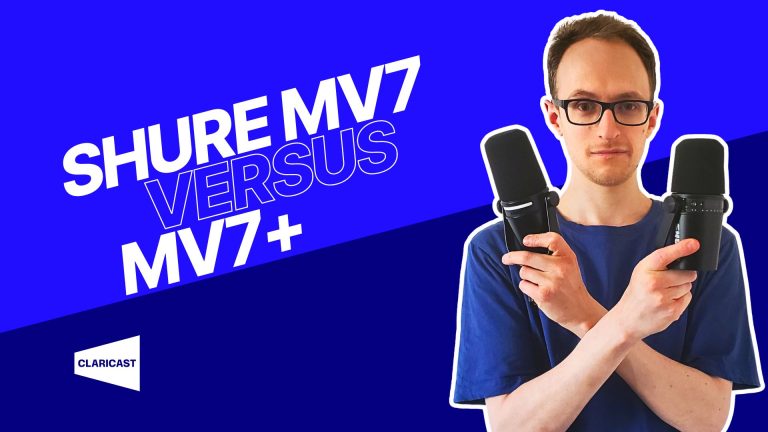Looking for a microphone to record your podcast with? You may have noticed both USB and XLR mics cropping up. In this article, you’re going to learn if a USB or XLR microphone for podcasting is right for you. We’ll go over the differences and you’ll find out which is right for your situation.
Note: This article may contain affiliate links. We earn a small portion of purchases make through these links.
What’s The Difference?
So when we’re talking about USB and XLR, we’re talking about the connector at the bottom of the mic where you plug your cable in to connect it to your system.
You’re likely already familiar with USB connectors. They’re either a small rectangular shape or a small rounded rectangle shape. You’ll find them in all sorts of devices like your phone and USB memory sticks.

USB microphones also have a built-in amplifier or ‘preamp’ which boosts the level of volume/signal of your voice recording. You can plug them directly into your computer and get started with recording your podcast with minimal effort or equipment.
An XLR connector, on the other hand, is a larger, round, three-pin connector. An XLR-connected mic requires a bit more work to get set up because you can’t plug them directly into your computer.

Firstly, you won’t have an XLR connection on your computer. And secondly, they don’t have a preamp built-in, meaning the signal would be very quiet if you were to record it directly. So to record with an XLR-connected microphone, you also need an audio interface or mixer, which we’ll talk about shortly.

Which Is Right For You?
So, should you use a USB or XLR microphone for podcasting?
If you want to keep things simple, USB is the way to go. It’s perfect for solo podcasters or remote interview podcasters who don’t want to get bogged down in the technical side of things.
And if you want to keep it simple and portable with your setup, a USB microphone like the Audio-Technica ATR 2100x lets you plug directly into your computer, and then it will pop up in whatever recording app you’re using, whether that’s Riverside, Audacity, or Zoom.

One thing that USB microphones don’t do particularly well is make it easy to record two people in the same room. Most computers and USB microphones won’t allow you to plug in two USB mics at once, meaning that you’d need two computers recording separately.
Alternatively, you can get yourself an audio interface with two XLR inputs and plug in two XLR microphones, meaning you can record two or more speakers at once to the same computer. The Focusrite Vocaster Two, for example, has two XLR inputs.

You plug the box into the USB port of your computer, install the software that it comes with, and then you’ll see the device pop up in whatever recording software that you’re using.
Using a digital audio workstation like Reaper or GarageBand? It will allow you to choose which microphone each track is picked up from.
Another benefit of using XLR microphones is that they typically record a higher quality recording. They’re less prone to noise and offer more flexibility. This is because you can switch out your mics and interface as you see fit.
The Verdict
So based on these factors, which is right for you? If you want to keep things as simple and portable as possible, a USB microphone like the ATR2100x or the Shure MV7+ would be a great option.
If you want to ensure you’re recording in maximum quality, if you’re recording multiple people in the same room, and if you want maximum flexibility and budget isn’t too much of an issue, then XLR is your best bet.
Both of the microphones that we’ve mentioned in this article have both USB and XLR inputs. So if you’re not sure or you’re not sure how your podcast is going to evolve over time, buying something like a Shure MV7+ and using it as a USB microphone means you’ll be open to expanding in the future and making use of the benefits of XLR.
Sound Comparison
To hear a comparison between an XLR and USB recording, see the video version of this post above.
And there you have it, a closer look between using a USB or XLR microphone for podcasting. Whichever situation you’re in, there’s a microphone out there for you!




